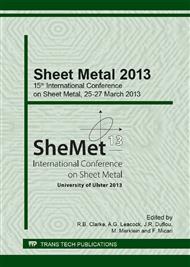p.484
p.492
p.503
p.511
p.521
p.529
p.537
p.547
p.557
Advances in Monitoring Die Condition during Superplastic Forming
Abstract:
Superplastic forming of titanium is typically restricted to low volume, high value products due to the high costs inherent in the current process. Problems contributing to the high costs stem from the interactions that take place at the die/part interface and include; poor part surface finish due to the build-up of corrosion products on the die surface and part distortion due to adhesion at the die surface. This paper describes novel methods for the investigation of the build-up of corrosion products on the die using surface digitization tools with laboratory based simulations of the forming conditions and a novel method for monitoring, analyzing and quantifying the die surface condition in a production environment using a combination of thermal imaging techniques and image analysis.
Info:
Periodical:
Pages:
557-564
Citation:
Online since:
April 2013
Authors:
Price:
Сopyright:
© 2013 Trans Tech Publications Ltd. All Rights Reserved
Share:
Citation:


